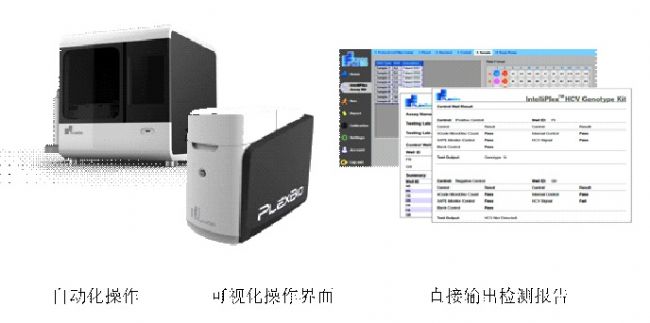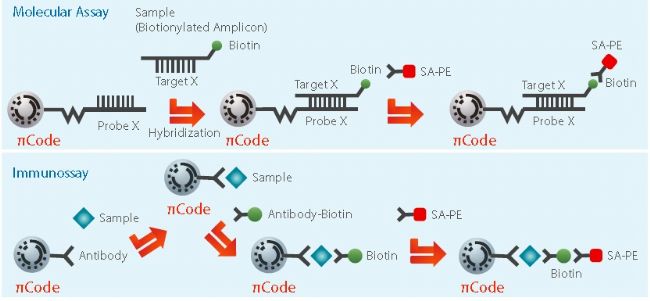Introduction to PlexBio "Image Coding Biomarker Multiple Analysis System"
Shanghai Dianao Biotechnology Co., Ltd.
Foreword:
The examination of diseases has always been an indispensable part of medicine. The doctor needs to rely on the patient's test report to determine the method of treatment. In the era of personalized medicine, invasive, rapid, accurate, and highly sensitive in vitro diagnostic (IVD) technology has become an important means of clinical diagnosis. New in vitro diagnostic techniques have been developed to achieve the goal of saving inspection time, saving manpower, and reducing sample usage. The multiple analysis of biomarkers is an important solution to meet the above objectives. PlexBio's "Image-Coding Biomarker Multiple Analysis System" is equivalent to performing hundreds of PCR or ELISA experiments simultaneously in a single well. It can simultaneously obtain tens or even hundreds of biomarker results in a single reaction, providing physicians with effective Rapid and diverse clinical diagnostic data, assisting doctors in the determination and selection of medical methods, meeting clinical needs and reducing medical costs, bringing new opportunities for personalized medicine.
 Figure 1. PlexBio “Image-Coding Biomarker Multiple Analysis Systemâ€
Figure 1. PlexBio “Image-Coding Biomarker Multiple Analysis Systemâ€
Image Coding πCode Technology - Opening a New Chapter in Multi-analysis of Biomarkers
πCode is short for Precision Image Code (piCode), and πCode MicroDisc is an ultra-small microchip (~50μm) made with high-tech semiconductor technology. It can form 16,000 different images of magnetic images, which can obtain 16,000 different image codes, which is equivalent to each type of magnetic film with unique encoding, just like the markers plus their own unique fingerprints, combined with the accurate image recognition technology of PlexBio instrument. , greatly increasing the flexibility and recognition of detection.

Figure 2. Encoding biomarkers using different images on a circular magnetic patch
The magnetic sheet is chemically treated, and the antibody molecules or gene probes for different analytes can be covalently cross-linked to a specific coded magnetic sheet, and each of the encoded magnetic sheets corresponds to the corresponding object to be tested. Researchers can use the platform to tailor protein or DNA analysis methods to mix magnetic sheets and samples in liquid media for effective reaction kinetics. The antibody is attached to the magnetic sheet, and can be paired with the antigen to be detected, and then labeled with a specific fluorophore; the nucleic acid probe is attached to the magnetic sheet to be paired with the nucleic acid to be detected, and a specific fluorophore can be labeled. So researchers can use this analysis system to tailor a protein or DNA analysis method. The PlexBio instrument uses an imaging method to acquire an image of a magnetic sheet, and the magnetic sheet distinguishes different objects to be detected. Then, by reading the fluorescence values ​​corresponding to the different coded magnetic pieces, the concentration of different objects to be detected is judged, thereby performing qualitative or quantitative multiple detection.
 Figure 3. How the PlexBio platform works
Figure 3. How the PlexBio platform works
Product Features - Make biomarker multiple detection more accessible
Personalization: Marks can be designed according to the needs of individual applications, and get their own test results.
High throughput: 96 sets of samples can be automated at the same time.
Fast: The time to read a 96-well plate is less than 60 minutes.
High sensitivity: The detection sensitivities of DNA and protein are: DNA: 0.05%-0.1% and protein: pg-ng/mL levels.
Multiple detection: Single wells simultaneously detect hundreds of targets. Plexbio requires only 50 wells to perform the 26 96-well plates required for a single-check assay.
Low cost of testing: Eliminate the limitation of being unable to carry out work due to high operating costs.
Wide range of applications:
(1) Single gene mutation detection:
In the diagnosis and treatment of tumor diseases, the advantages of targeted drugs are becoming more and more obvious. Numerous studies have shown that specific gene mutations in tumor cell pathways are closely related to the efficacy of targeted drugs. Therefore, tumor patients must perform specific tumor gene detection to determine the mutation point of tumor genes before applying targeted drug therapy. Sexually select targeted drugs to maximize the therapeutic effect, reduce the side effects of drugs, and avoid ineffective treatment. For example, KRAS gene mutation screening can help doctors to screen for targeted drugs such as Cetuximab or Panitumumab for colon cancer, stomach cancer, head and neck cancer, and non-small cell lung cancer patients. Patients with a wild-type KRAS gene can benefit from the treatment of cetuximab or panitumumab.
PlexBio's KRAS gene mutation detection kit is characterized by the simultaneous detection of twelve KRAS gene mutations in a single well (KRAS gene corresponds to mutations in the twelfth and thirteenth amino acid DNA sequences); sensitivity is 0.1-0.01% higher It can be detected (only the mutated gene fragment is amplified); the minimum detection amount is only 10 ng of DNA; the detection can be completed within 6 hours (including sample processing time).
Other kits include: BRAF gene mutation detection kit, EGFR gene mutation detection kit, NRAS gene mutation detection kit, PIK3CA gene mutation detection kit, ALK gene recombinant detection kit, ROS1 gene recombinant detection kit, RET/NTRK1 Gene Recombination Detection Kit, Hepatitis C Virus (HCV) Genotyping Kit.
(2) Early cancer screening:
The only way out for cancer prevention and treatment is "three early", namely: early detection, early diagnosis, early treatment. Early cancer screening can provide clues to early detection of cancer. Only high-sensitivity, easy-to-use, low-cost, and easy-to-accept screening methods can be used in large populations to find more early cancer patients and high-risk populations. Taking colorectal cancer as an example, colorectal cancer (CRC) is the third leading cause of cancer death. At least 25% of patients with colorectal cancer diagnose liver metastases at initial diagnosis, resulting in a 5-year survival rate of 10 patients with distant cancer metastasis. -20%. Although fecal occult blood test, sigmoidoscopy or colonoscopy has become a routine method for detecting early colorectal cancer, the sensitivity of the above tests is insufficient, or the invasive test procedure is unacceptable to some patients, showing the current colorectal cancer. There is still a huge gap between the screening methods and the huge demand for more optimized testing tools.
PlexBio's early screening test for non-invasive colorectal cancer features simultaneous detection of 18 mutation hotspots in the biomarker genes APC, β-catenin, KRAS and BRAF; designed for early cancer screening, unlike the general market The mutation detection reagent kit is designed for prognostic use; the non-invasive screening method reduces unnecessary risks and side effects; compared to invasive screening methods, the detection cost is lower.
(3) Virus detection:
Human papillomavirus (HPV) is the most common infectious disease in humans that is transmitted through sexual activity. Based on its association with cancer, HPV can be divided into high-risk and low-risk viruses, and high-risk human papillomavirus infection can cause cervical cancer and other cancers.
PlexBio's Human Papilloma Virus (HPV) Genotyping Diagnostic Reagent is a multi-detection reagent that can simultaneously detect 30 genotypes of human papillomavirus: "16 high-risk types" + "3 potential-dangerous types" + "11 low risk types". The PlexBio Human Papilloma Virus Genotyping Reagent utilizes the multivariate πCode technology superiority test system to effectively increase the sensitivity and accuracy of the reagents, and can complete and provide test results for 96 specimens within 5 hours, greatly reducing reagents and reagents. The cost of personnel. The 30 detection genotypes are: 6, 11, 16, 18, 26, 31, 33, 35, 39, 40, 42, 43, 44, 45, 51, 52, 53, 54, 55, 56, 58, 59 , 61, 66, 68, 70, 73, 81, 82/MM4, 83.
Other kits include: Human papillomavirus (HPV) Branched DNA diagnostic reagent.
(4) Prenatal diagnosis:
The ToRCH diagnostic reagent is a blood test that checks patients for infection with certain infectious diseases. This test quantifies the amount of antibodies produced in the blood for certain infectious agents. ToRCH is a generic term for toxoplasma (TO), rubella virus (RV), cytomegalovirus (CMV), and herpes simplex virus (HSV). PlexBio's ToRCH PLUS multi-vector test reagent not only measures the antibodies produced by Toxoplasmosis, Rubella, Cytomegalovirus (CMV), and Herpes simplex virus (HSV I and II) in the same way as traditional ToRCH, but also measures other infectivity. The disease is, for example, human small DNA virus B19 (Human parvovirus B19). The traditional ToRCH test uses ELISA to test each infectious agent one by one, which is time consuming and costly. PlexBio's diversified assay technology is particularly well-suited for such assays, allowing all of these infectious agents to be quantified in the blood in one experiment.
Other kits include: diagnostic reagents for pregnancy toxemia.
(5) Food safety testing:
Food is the material basis for human survival and social development. Food safety is the focus of major social issues and people's livelihood. To ensure the reduction of foodborne diseases, advanced food inspection and testing technology is an effective means to ensure food safety. PlexBio's detection platform can be used for food safety testing.
(6) Infectious disease detection:
Common infectious diseases are mainly nail liver, hepatitis B, hepatitis C, hepatitis E, syphilis, AIDS, gonorrhea and tuberculosis. Infectious disease detection is of great significance for preventing disease transmission. For example, before blood donation, it is necessary to check whether it is infected with common infectious diseases to avoid the spread of diseases. PlexBio's infectious disease test can detect multiple infectious disease proteins or viral DNA in a single well, and has the advantages of multiple detection, high sensitivity, low detection, short time, and low price.
(7) Detection of intestinal microbial pathogens:
Intestinal microbial pathogens are the cause of intestinal diseases. Detection of intestinal microbial pathogens is important for the discovery, diagnosis and treatment of intestinal diseases. PlexBio's intestinal microbial pathogen detection can simultaneously detect DNA from a variety of microbial pathogens in a single well, with multiple detection, high sensitivity, low detection, short time, and low cost.
(8) Microbial identification and classification:
Microbial identification and classification is a key step in the study of microbial species relationships. PlexBio's Microbial Identification and Classification Kit identifies microbial DNA in a single microwell to identify and classify microbial species.
to sum up:
Compared with other common “biomarker multiplex analysis systems†on the market, PlexBio system has “image coded signal is more stableâ€, “to be detected can be tracedâ€, “effectively reduce cross-contaminationâ€, “automatic operation is more efficient†", "lower cost" and other advantages. Product introduction link: http://?equipid=4089196&division=699
For further understanding, please contact “Shanghai Dian Biotech Co., Ltd.â€, website: , contact information (Ms. Liu). Or scan the QR code below to add the WeChat public account "tekontech".

Ascorbic acid (vitamin C) is an essential vitamin that is well known for its effects on the immune system. L ascorbic acid bulk vitamin C powder is naturally sour and is commonly used in candy to add a sour taste. When it is ingested, it goes to work circulating through all of the watery areas of the human body (once it has been absorbed into the intestines, of course). From there, ascorbic acid may help in the fortification of collagen while acting as an antioxidant during the trip. It may also assist in the repair of damaged tissue and in helping to maintain healthy levels of collagen in already healthy individuals. Vitamin C also has a host of other general uses.L-ascorbic acid bulk vitamin C powder is a colorless crystal, odourless, acidic taste. Soluble in water and ethanol. Stable in dry air , and its solution is not stable. As well as, L-ascorbic acid bulk vitamin C powder takes part in many metabolism procedures in the human body, helps decrease brittleness of blood capillaries and increase body resistance
Vitamin A series
Vitamin B series
Vitamin C series
Vitamin E series
Vitamin A acetate oil
1,000,000IU/G
Vitamin A acetate powder
325,000IU/G 500,000IU/G
Vitamin A palmitate oil
1,000,000IU/G 1,700,000IU/G
Vitamin A palmitate powder
250,000IU/G 500,000IU/G
Vitamin C
99%
Natural Vitamin E powder
15%,30%
Natural Vitamin E oil
50%,96%
Vitamins Powder,Vtamin A Powder,Vitamin B Powder,Vitamin C Powder
XI'AN PLANT BIO-ENGINEERING CO.,LTD , https://www.plantbic.com